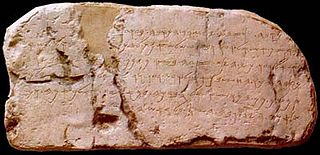 W
WBiblical Aramaic is the form of Aramaic that is used in the books of Daniel and Ezra in the Hebrew Bible. It should not be confused with the Aramaic paraphrases, explanations and expansions of the Hebrew scriptures, which are known as targumim.
 W
WThe Babylonian vocalization, also known as Babylonian supralinear punctuation, or Babylonian pointing or Babylonian niqqud Hebrew: נִקּוּד בָּבְלִי) is a system of diacritics (niqqud) and vowel symbols assigned above the text and devised by the Masoretes of Babylon to add to the consonantal text of the Hebrew Bible to indicate the proper pronunciation of words, reflecting the Hebrew of Babylon. The Babylonian notation is no longer in use in any Jewish community, having been supplanted by the sublinear Tiberian vocalization. However, the Babylonian pronunciation as reflected in that notation appears to be the ancestor of that used by Yemenite Jews.
 W
WBiblical Hebrew, also called Classical Hebrew, is an archaic form of the Hebrew language, a language in the Canaanite branch of Semitic languages spoken by the Israelites in the area known as the Land of Israel, roughly west of the Jordan River and east of the Mediterranean Sea. The term "Hebrew" (ibrit) was not used for the language in the Bible, which was referred to as שפת כנען or יהודית, but the name was used in Ancient Greek and Mishnaic Hebrew texts.
 W
WBiblical languages are any of the languages employed in the original writings of the Bible. Partially owing to the significance of the Bible in society, Biblical languages are studied more widely than many other dead languages. Furthermore, some debates exist as to which language is the original language of a particular passage, and about whether a term has been properly translated from an ancient language into modern editions of the Bible. Scholars generally recognize three languages as original biblical languages: Hebrew, Aramaic, and Koine Greek.
 W
WIsraelian Hebrew is a northern dialect of biblical Hebrew (BH) proposed as an explanation for various irregular linguistic features of the Masoretic Text (MT) of the Hebrew Bible. It competes with the alternative explanation that such features are Aramaisms, indicative either of late dates of composition, or of editorial emendations. Although IH is not a new proposal, it only started gaining ground as a challenge to older arguments to late dates for some biblical texts since about a decade before the turn of the 21st century: linguistic variation in the Hebrew Bible might be better explained by synchronic rather than diachronic linguistics, meaning various biblical texts could be significantly older than many 20th century scholars supposed.
 W
WThe Palestinian vocalization, Palestinian pointing, Palestinian niqqud or Eretz Israeli vocalization is an extinct system of diacritics (niqqud) devised by the Masoretes of Jerusalem to add to the consonantal text of the Hebrew Bible to indicate vowel quality, reflecting the Hebrew of Jerusalem. The Palestinian system is no longer in use, having been supplanted by the Tiberian vocalization system.
 W
WQere and Ketiv, from the Aramaic qere or q're, קְרֵי and ketiv, or ketib, kethib, kethibh, kethiv, כְּתִיב, also known as "keri uchesiv" or "keri uchetiv," refers to a system for marking differences between what is written in the consonantal text of the Hebrew Bible, as preserved by scribal tradition, and what is read. In such situations, the Qere is the technical orthographic device used to indicate the pronunciation of the words in the Masoretic text of the Hebrew language scriptures (Tanakh), while the Ketiv indicates their written form, as inherited from tradition.
 W
WThe Samaritan vocalization is a system of diacritics devised by the Samaritans to add to the consonantal text of the Samaritan Pentateuch and to Samaritan prayer books to indicate vowel quality, reflecting Samaritan Hebrew. It is estimated that the Samaritan vocalization was invented around the 10th century CE. Only the most important vowels were indicated, and variation exists within the system between different manuscripts.
 W
WTiberian Hebrew is the canonical pronunciation of the Hebrew Bible or Tanakh committed to writing by Masoretic scholars living in the Jewish community of Tiberias in ancient Galilee c. 750–950 CE under the Abbasid Caliphate. They wrote in the form of Tiberian vocalization, which employed diacritics added to the Hebrew letters: vowel signs and consonant diacritics (nequdot) and the so-called accents. These together with the marginal notes masora magna and masora parva make up the Tiberian apparatus.
 W
WThe Tiberian vocalization, Tiberian pointing, or Tiberian niqqud is a system of diacritics (niqqud) devised by the Masoretes of Tiberias to add to the consonantal text of the Hebrew Bible to produce the Masoretic Text. The system soon became used to vocalize other Hebrew texts, as well.